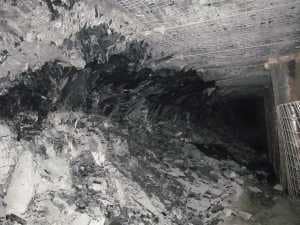Mining Feature: Two Sister Reports of Investigations on Ground Stress Research
Tuesday, July 21, 2020

Photo shows a deteriorating pillar rib due to high ground stress conditions in a western U.S. coal mine. Photo by NIOSH. (click image to enlarge)
Two Reports of Investigations provide detailed findings on ground stress redistribution resulting from mining, which could ultimately lead to significant improvements in the stability of mine excavations, thereby ensuring more stable ground and a safer working environment for miners in western U.S. longwall mines.
As part of NIOSH’s ongoing efforts to reduce fatalities and injuries in the mining industry resulting from ground failure, researchers explored options for assessing ground safety with stress analysis tools in the design of longwall coal panels at two western U.S. coal mines.
 In “Ground Stress in Mining (Part 1): Measurements and Observations at Two Western U.S. Longwall Mines,” researchers compiled two large data sets of observations and measurements while successive, adjacent panels of coal were retreated at each of the two study mines. These data sets include general observations of ground behavior, observations from ground condition surveys, measurements of pressure change with borehole pressure cells, and manual measurements of roof sag using sonic probes. By using various instruments and based on an observational survey of ground conditions, researchers recommended a procedure to detect the first arrival of mining-induced abutment stress ahead of the face. Taking such measurements helps to ensure an effective model calibration process.
In “Ground Stress in Mining (Part 1): Measurements and Observations at Two Western U.S. Longwall Mines,” researchers compiled two large data sets of observations and measurements while successive, adjacent panels of coal were retreated at each of the two study mines. These data sets include general observations of ground behavior, observations from ground condition surveys, measurements of pressure change with borehole pressure cells, and manual measurements of roof sag using sonic probes. By using various instruments and based on an observational survey of ground conditions, researchers recommended a procedure to detect the first arrival of mining-induced abutment stress ahead of the face. Taking such measurements helps to ensure an effective model calibration process.
Researchers also established a procedure to determine load transfer distance ahead of the face by way of detection methods involving borehole pressure cells, instrumented support Cans, closure measurements, and ground condition surveys. Knowledge of load transfer distance allows for calibration of numerical models to evaluate mine layout designs that can reduce the risk of ground instabilities.
“Ground Stress in Mining (Part 2): Calibrating and Verifying Longwall Stress Models” describes the second phase of the research, detailing how numerical models can be used to calculate ground stress in mines and to evaluate mine layout design. The goal is to establish improved procedures for predicting ground stress, which can aid mines in identifying safe and unsafe working areas and escapeways. Mine Safety and Health Administration guidance (in Appendix F of the document) recommends an approach to calibrating models to observations, but the guidance does not include recommendations for using in-situ measurements to calibrate such models. NIOSH research supplements this guidance by exploring and demonstrating procedures for calibrating numerical models to both observations and measurements.
In consideration of appropriate strength models that might sufficiently calculate load transfer distance, measurements indicate that ribs are sometimes able to withstand much more stress than that calculated using the most common yield strengths models, suggesting that strain-hardening might be an important factor in coal pillar behavior near pillar ribs.
- A Comparison of Longwall & Continuous Mining Safety in U.S. Coal Mines 1988-1997
- Development and Application of the Coal Mine Roof Rating (CMRR)
- Diagnosing and Controlling Moisture-Sensitive Roof in Coal Mines
- Performance Characteristics for Welded Wire Screen Used for Surface Control in Underground Coal Mines
- Prediction of Longwall Methane Emissions: An Evaluation of the Influence of Mining Practices on Gas Emissions and Methane Control Systems